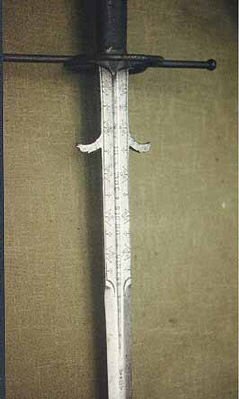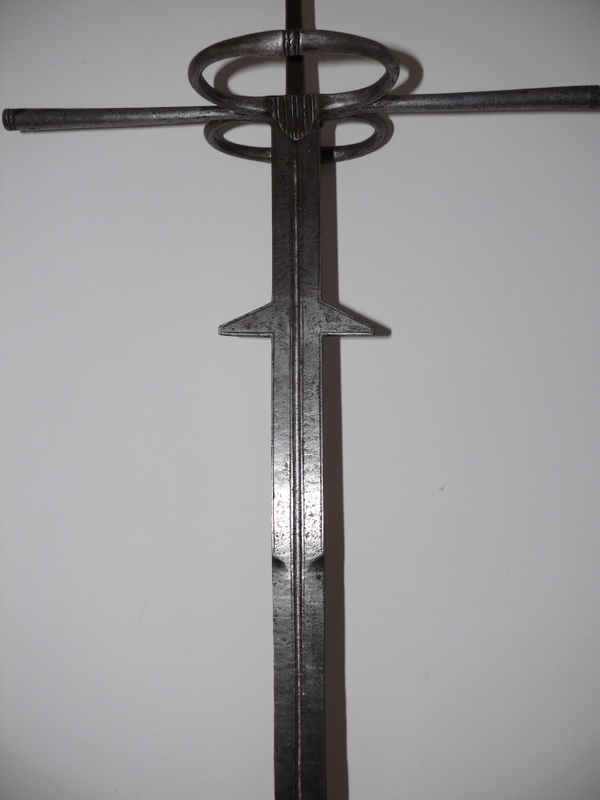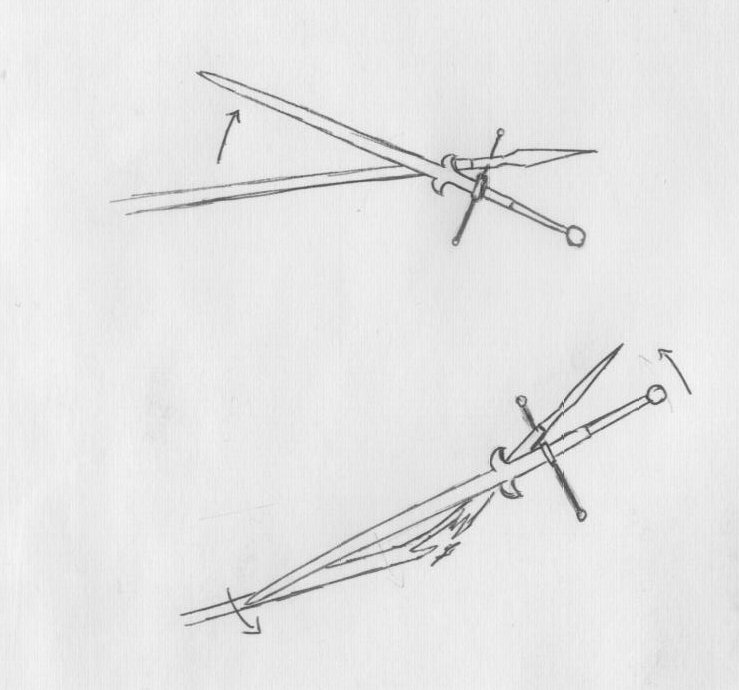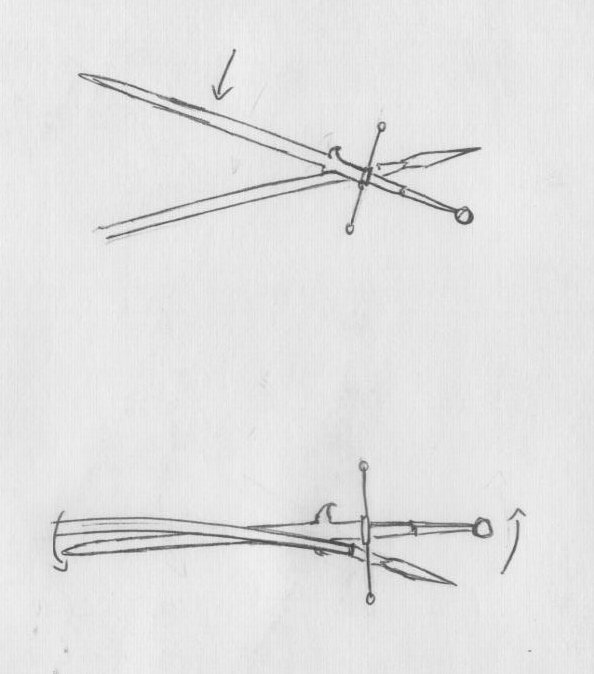| Author |
Message |
|
Matthew P. Adams
|
 Posted: Mon 06 Feb, 2012 5:17 am Post subject: True two handed sword measurements? Posted: Mon 06 Feb, 2012 5:17 am Post subject: True two handed sword measurements? |
 |
|
Spadone's Montante's and Dopplehanders...
Just like it says, I'm looking for links, pictures, stats, and measurements. Particularly of interest is the COG of originals, and tangs of originals. I have seen the ARMA page "the weighty issue of two handed great swords" and it's been of great help, I also saw the post on here about weights and lengths of originals, but not a whole lot about the center of gravity on them. Did they tend to be weighted more for cutting or thrusting? Did it just depend on the individual weapon? Was there a general difference between say, the landsknecht Dopplehanders and the Montante?
And I am more interested in the users than in the bearing swords.
Cheers!
Matthew
"We do not rise to the level of our expectations. We fall to the level of our training" Archilochus, Greek Soldier, Poet, c. 650 BC
|
|
  |
 |
Daniel Wallace

Location: Pennsylvania USA Joined: 07 Aug 2011
Posts: 580
|
 Posted: Mon 06 Feb, 2012 9:58 am Post subject: Posted: Mon 06 Feb, 2012 9:58 am Post subject: |
 |
|
i've been looking into a sword for the past few months that falls under the classification of two hander/Zweihänder when you see them in museums. but my research is pointing that this swords and the other examples i've been finding of it, predate what i'd consider a true Zweihänder.
it's a slender 2 handed sword, and they average right about the 55 inch length and are around 4 lbs with flat or downward turned parring lugs. they almost seem to be a sword style that developed between the hand-and-half long swords and zewihander. i've noticed that they are also classified as fechtschwert at times. but this doesn't seem to be the case with the one i've been looking into.
now i can't tell you exactly where the POB is in the sword, but from what i can tell, all of these slender examples are still consider to be blade heavy. these swords look to be able to provide both a good thrust as well as a cut, even though their slender nature at first glance may lead you to think other wise.
a Zweihander on the other hand looks to be more of a cutting weapon, their blade is broad and seems to taper out to the point instead of in at times, they average 55 inchs and up - usually weight in at about 5-7 lbs (for those that aren't bearing swords) which you've probably read in he arma article.
your classification of Montante, i'm not too familiar with, a quick search brings up the same terms as long sword, zweihander, landsknecht. montante seems to be a spanish term for the same style of sword. below i've got a picture of the style of sword i've looking into - maybe it's the same thing as i do know there are 2 examples in the cleveland museum that have the same qualities and are spanish in origin. which might fall under your classification of montante.
 Attachment: 61.34 KB Attachment: 61.34 KB

|
|
  |
 |
|
Neil Melville
|
 Posted: Tue 07 Feb, 2012 7:43 am Post subject: Posted: Tue 07 Feb, 2012 7:43 am Post subject: |
 |
|
Hi Daniel,
My info may be of more interest to you than to Matthew - sorry Matthew. The 2 two-handers in Cleveland are certainly Spanish (Toledo), nos.1916.1507 and 1916.1509, weighing 2.24kg and 2.2kg (just over/under 5lbs), and just under/over 66 inches respectively. I don't have any info on the PoB. The sword in your photo, in the Musee de l' Armee, Paris, is almost certainly of the same type and similar dimensions, but I don't have any details. This is a typical Spanish style and was very likely used as much for thrusting as for cutting.
Cheers, Neil
N Melville
|
|
  |
 |
|
Matthew P. Adams
|
 Posted: Tue 07 Feb, 2012 9:29 am Post subject: Posted: Tue 07 Feb, 2012 9:29 am Post subject: |
 |
|
Part of my curiosity is, were the Landsknecht dopplehanders used in the same manner as a montante (when not facing a pike line) Did combatants perform the Figueyredo's Montante Rules with both weapons? are they the same more or less, and only stylistically different, or were they two sub divisions of two handed sword?
I was asking about balance point to see if there were any trends.
"We do not rise to the level of our expectations. We fall to the level of our training" Archilochus, Greek Soldier, Poet, c. 650 BC
|
|
  |
 |
Daniel Wallace

Location: Pennsylvania USA Joined: 07 Aug 2011
Posts: 580
|
 Posted: Tue 07 Feb, 2012 10:10 am Post subject: Posted: Tue 07 Feb, 2012 10:10 am Post subject: |
 |
|
Neil, i have been wanting to look into those two swords lately for comparison reasons, i know the sword i'm looking into is german, there is another in leeds which i haven't been able to find photos of, and one in the tower of london pictured below.
and Matthew, as i've been looking into these sword styles i tend to think there may be a difference between them though they still would be consider two hander. now i can only speculate because i've only got hard info on one of the 4 i know of - i have to get a comparison of dates and dimensions and other details before i could present a accurate statement.
now this is speculation, but my source is leading me to believe that the sword i'm working with was used, it has the presence of damage. but because the two that i have detailed photos of are decorated a little more than usual, i'm leaning toward them not being swords of war. but i can't prove that. my source and i can only speculate that these may be a type dueling sword, but i can't back up that statement without more evidence. theses swords just seem to be built for a different purpose.
i have to have a little more alone time with a few more examples to get a better idea of their use, i'm also going to have to pick up a few books on two handers and their use, i'm familiar with long sword, but very little with actual two handed combat 
unfortunately there are not too may examples that we can get our hands on to find the pob ourselves, but maybe as i keep cracking away at this i'll find some more information.
 Attachment: 18.91 KB Attachment: 18.91 KB

|
|
  |
 |
Glen A Cleeton

|
 Posted: Tue 07 Feb, 2012 11:19 am Post subject: Posted: Tue 07 Feb, 2012 11:19 am Post subject: |
 |
|
There is this rather old reference but if you don't already have it handy, might be of use.
http://www.palus.demon.co.uk/Sword_Stats.html
Matt Galas continues to write and research information for the HES HEMA community and might be a good source for some of the information you are looking for.
Cheers
GC
Oh yes, to add
A great many swords of many types fall into the mass distribution of the center of gravity working out to about a third of the overall sword length. That is by no means a maxim but something one can ball park without knowing the specific pob. The reat big jobs with ricasso take into consideration of the hand beyond the main guard.
|
|
  |
 |
|
Neil Melville
|
 Posted: Wed 08 Feb, 2012 5:07 am Post subject: Posted: Wed 08 Feb, 2012 5:07 am Post subject: |
 |
|
Daniel,
I realise that this isn't helping with what you really want, but to clear up a possible confusion: the sword in your second photo is not in the Tower - it's in the RA museum in Leeds (IX-991), so you do have it! By the way it looks very similar to the Spanish two-handers in Cleveland and Paris, apart from the curled parrying lugs (instead of the straight 'book-end' lugs on the Spanish swords). It is dated 1529 and signed IOHANNES which suggests Germany but might not be. Its dimensions are similar, too: length 156.5cm (under 62 ins), weight 2.28kg (5lbs1oz). They could be battle swords but carried by officers (also as mark of rank) hence the better quality.
Cheers,
Neil
N Melville
|
|
  |
 |
Daniel Wallace

Location: Pennsylvania USA Joined: 07 Aug 2011
Posts: 580
|
 Posted: Wed 08 Feb, 2012 9:14 am Post subject: Posted: Wed 08 Feb, 2012 9:14 am Post subject: |
 |
|
Niel thanks for the clarification. i found this picture here some years ago and it was labeled from the tower of london. this is almost a partner to the sword i've been doing most of my research with. in fact their so similar accept for the engraving and hilt i'd wonder if their from the same blade smith? all of it's measurements fall about the same as well.
i've been thinking for a while about jumping over the state line to the cleveland museum it's only a few hours away for me. i would really like to get a look at these swords, see what i can find out about them by getting a closer look. but before i do that i think i'll attempt to send an e mail off to them seeing if anyone there can tell me a little more about them.
and i'll have to dive into that link Glen posted up too, i looked over it briefly - there's a lot of good stats there.
|
|
  |
 |
|
Neil Melville
|
 Posted: Wed 08 Feb, 2012 10:51 am Post subject: Posted: Wed 08 Feb, 2012 10:51 am Post subject: |
 |
|
Daniel, any chance you could post a photo of the sword you are researching? I'd be interested to see how it compares. And any photos you can get of the Cleveland swords! Good luck.
Neil
N Melville
|
|
  |
 |
|
Cornelis Tromp
Location: Holland Joined: 03 Jan 2010
Posts: 87
|
 Posted: Thu 09 Feb, 2012 12:51 am Post subject: Posted: Thu 09 Feb, 2012 12:51 am Post subject: |
 |
|
I apologize to break into this thread, I found another picture of 2 handers in the cleveland art museum, I hope it helps in someway.
On this picture is also good to see the size in respect to the processional late 16thC sword.
Those small 2handers seem very manageable ones to fight with.
There are also longer swords of this type known, for example g-16 in the Real Armeria and a very long thrusting sword in a private collection.
To appoint them to a particular country (Spain, Germany) seems to me very difficult. especially since German swordsmiths in the middle of the 16th century adopted (trade)marks from Toledo and vice versa, see eg wolfgang standler marks. (wolfgang standler made beautiful 2-handers, cf Bern Museum).
best,
 Attachment: 72.74 KB Attachment: 72.74 KB

 Attachment: 70.4 KB Attachment: 70.4 KB

 Attachment: 57.11 KB Attachment: 57.11 KB

 Attachment: 150.54 KB Attachment: 150.54 KB

 Attachment: 159.46 KB Attachment: 159.46 KB

 Attachment: 53.32 KB Attachment: 53.32 KB

|
|
  |
 |
Daniel Wallace

Location: Pennsylvania USA Joined: 07 Aug 2011
Posts: 580
|
 Posted: Thu 09 Feb, 2012 9:36 am Post subject: Posted: Thu 09 Feb, 2012 9:36 am Post subject: |
 |
|
ahhh . . . . there they are.
yes their all very similar. the grips on these two are much longer but other than that the styles of the blades are almost spot on, accept for minor differences but they all have 1 aspect that's the same. the parierhaken are rather close to the guard as apposed to their bigger cousin there.
now again i have to get do some reading up on how to use a two hander to understand this a little better but maybe you can also correct me if i'm wrong. a Zweihänder's parierhaken were used similar as a second hilt when sword halfting to protect the hand. there is ample room between the lugs and upper guard that once the off hand if free will find quickly and easily.
were as these slender swords don't seem to have too much room for your hand above the guard. drawing from my information - the ricasso area below the guard is just big enough for the off hand. i recently read an article that someone had posted up for me about fechschwert and there was an explanation that pareirhaken's developed to guard one's fingers when you have the appropriate long sword grip. i'm thinking of the italian grip where you'd have your index finger griped around the quillon. (my own personal preference is to have the index finger above the grip and also the thumb, it just feel natural to me) so i can see the advantage of the paring lugs.
I've also come under the understanding that this style of parierhaken could aid in a technique call "Schild of the Fechtfedern" which i haven't taken the time to translate. but seems to be a way to keeping an opponent blade way. i suggested that they look to be advantageous on the binding of another blade. your attackers strikes and you naturally use the flat of you blade in a block, but it would seem to me that it wouldn't be difficult to manipulate the blade - catching it in the 'fork' of the parierhaken - which may aid in the leaver action to bind up a blade to wrench it way from your attacker.
well that's a good theory but i don't have anything to back it up, i haven't had the pleasure of handling a sword like this, nor do i have the appropriate knowledge to apply to sword handling. there seems to be very little in the area of reproductions that match them, so i like to have one made, or modify an existing blade to something similar.
thanks for all the information you've been putting up, catalog numbers will help a lot when i work up the letter asking for info on the swords in cleveland, also the one in leeds for for matter. hopefully i'll find someone with some insight into their history that's viewed them up close.
i feel like i've been stealing the thread away from Matthew, but i think he and i are both looking into the same thing. 
|
|
  |
 |
Vincent C

Location: Northern VA Joined: 24 Aug 2009
Posts: 84
|
 Posted: Thu 09 Feb, 2012 11:18 am Post subject: Posted: Thu 09 Feb, 2012 11:18 am Post subject: |
 |
|
My experience with parrying hooks suggest that they're used for anti-winding by smaller blades so that you can keep your blade relatively free to engage multiple foes without having to worry about someone wrapping their point around the cross-guard.
Apart from that, you'll notice how on some of them the ricasso extends well past the parrying hooks, I don't know if what I'm about to say was their intended purpose, but...
I like to put my hand outside on the ricasso extension when halfswording. It lets me get a lock on the opponents blade between hooks and the guard. When doing the cloak guard techniques, grabbing the ricasso in front of the hooks also lets me engage people with the blade who get close without having to move myself and create an opening to who I guard, keeping them safe. When they strike, I can catch the blade again between the hooks and the guard and manuever it where ever I want safely, letting me thrust and cut at my leisure.
Like I said, I don't know if that was the intended purpose, but it's what I found works.
I love those two swords from Cleveland, I really wish I could see them in person.
Honor, compassion, knowledge.
|
|
  |
 |
|
Cornelis Tromp
Location: Holland Joined: 03 Jan 2010
Posts: 87
|
 Posted: Thu 09 Feb, 2012 11:35 am Post subject: Posted: Thu 09 Feb, 2012 11:35 am Post subject: |
 |
|
fechtfedern or federschwert is a modern German termologie for 16 th century light training sword with rounded tip.
it has the same weight and balance as the real fighting sword it must imitate.
feather sword or fighting feather. on those training swords the Parierhaken (“parrying hooks”) are formed by the short ricasso. see picture of 16thC training sword in Museum of Istanbul.
(schild is shield/guard)
back to the real cleveland a.m. fighting swords.
the long ricasso has the function that the sword can be used as a pole arm against such as cavalry, the extended grip is formed because of the long ricasso.
The Parierhaken (“parrying hooks”) ensure, as a ricasso guard, that no weapon can slide down the blade on the hand holding the ricasso.
best,
 Attachment: 29.57 KB Attachment: 29.57 KB

 Attachment: 78.16 KB Attachment: 78.16 KB

|
|
  |
 |
Bill Grandy
myArmoury Team


|
 Posted: Thu 09 Feb, 2012 12:04 pm Post subject: Posted: Thu 09 Feb, 2012 12:04 pm Post subject: |
 |
|
| Vincent C wrote: | | My experience with parrying hooks suggest that they're used for anti-winding by smaller blades so that you can keep your blade relatively free to engage multiple foes without having to worry about someone wrapping their point around the cross-guard. |
The Bolognese masters described the use of the lugs in the way that people have mentioned above - As a second guard for techniques where you grasp the ricasso. These techniques are primarily for fighting against polearms, such as in this guard from Achilles Marozzo (guardia contra arme inhastate):

HistoricalHandcrafts.com
-Inspired by History, Crafted by Hand
"For practice is better than artfulness. Your exercise can do well without artfulness, but artfulness is not much good without the exercise.” -anonymous 15th century fencing master, MS 3227a
|
|
   |
 |
Daniel Wallace

Location: Pennsylvania USA Joined: 07 Aug 2011
Posts: 580
|
 Posted: Fri 10 Feb, 2012 9:33 am Post subject: Posted: Fri 10 Feb, 2012 9:33 am Post subject: |
 |
|
Vincent, i noticed your idea right off of the bat when putting my sketch together. even though the ricasso beneath the parierhaken is limited, above them in all the examples of this sword it's more than enough for a hand. but i didn't not put together that the lugs could be used with the guard to bind. do you think that the shape of the parierhaken aids in this? reason being, i can't remembering seeing any examples of these swords having an upward turned set of lugs on them. they all seem to carry flat - or small protruding nubs. the leeds sword and german one are the only 2 i know of with the downward turned lugs.
the cleveland swords, i wish i could examine them like a professional, but that's highly unlikely. i will have to go there this summer to get the best look at them that i can.
i know there has been a lot of good discussions lately about 2 handers, i've been trying to follow along with them. is there any books (in english) about 2 hander techniques i could pick up - Bill already mentioned Achilles Marozzo. i'm looking for what would best fit for the slender style swords, so i can get a better idea about how history presents they were handled.
|
|
  |
 |
Daniel Wallace

Location: Pennsylvania USA Joined: 07 Aug 2011
Posts: 580
|
 Posted: Sat 11 Feb, 2012 10:25 am Post subject: Posted: Sat 11 Feb, 2012 10:25 am Post subject: |
 |
|
I got to thinking yesterday before i was off to work. again about vincent's handling of the sword, and the older thread that we had going on about two handers vs pikes.
it would seem to me not too probable to cut a pike. if you swing at it, i believe a blade would be more prone to bat it away than to actually cut it or cause much damage to it. then i had an idea that came from vincent's handling. what if you bound the pike instead of attempting to cut it?
i'm trying to add just a little of a real world exp. during my day job, i work for my local church, and hang banners with a specially made 20 foot pole. it wiggles like crazy, and the little bit of weight on the end of it, feels like 10 more lbs than it actually is the further out it is. if i have two hands on that, if someone else where to get an mechanical advantage on the end, it would be useless.
the same would be true for a pike? i wouldn't see why now. to cut a pike - it would be easier if it were fixed at both ends to something solid and then attempted to cut, but trying to do that in a battle situation probably rather rough to do.
on the other hand i had this idea below, i had to draw it out between jobs so it's crude. the idea is to bind the pike between the guard and parierhaken, and gain a mechanical advantage over the pike, attempting to break it, or gain control over it.
as i drew this out i did also think that binding the pike and actually grabbing it are two different things. the pike will still have thrusting ability in the bind, but there would become a point where the bind causing enough friction to stop the thrust, and potently break it, control it, or just have the man on the other end drop it before for lack of control on his part.
again it's just an idea, it's up for any debate. 
 Attachment: 57.41 KB Attachment: 57.41 KB

here the sword cuts up into the pike, with the off hand above the lugs and primary hand under the guard, the sword user binds the pike between the lugs and guard. leavering with the primary hand upward and downward with the off hand unitl the pike is bro
 Attachment: 46.03 KB Attachment: 46.03 KB

here, the sword cuts down into the pike and with the same hand placement, and the same bind, the sword controls the end of the pike and pushes it into the ground.
|
|
  |
 |
|
|
You cannot post new topics in this forum
You cannot reply to topics in this forum
You cannot edit your posts in this forum
You cannot delete your posts in this forum
You cannot vote in polls in this forum
You cannot attach files in this forum
You can download files in this forum
|
All contents © Copyright 2003-2025 myArmoury.com — All rights reserved
Discussion forums powered by phpBB © The phpBB Group
Switch to the Basic Low-bandwidth Version of the forum
|

